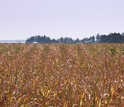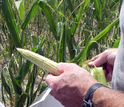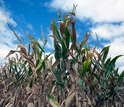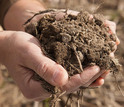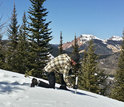News Release 16-127
Soil moisture, snowpack data could help predict 'flash droughts'
Severe 2012 drought could have been forecast months in advance, research shows
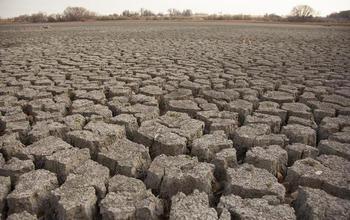
Flash droughts, like the one in the U.S. Southern Rockies and Midwest in 2012, can be predicted.
October 18, 2016
This material is available primarily for archival purposes. Telephone numbers or other contact information may be out of date; please see current contact information at media contacts.
The "flash drought" that unexpectedly gripped the U.S. Southern Rockies and Midwest in the summer of 2012 could have been predicted months in advance using soil moisture and snowpack data, according to new research.
Scientists at the National Center for Atmospheric Research (NCAR) analyzed the conditions leading to the 2012 drought -- which resulted in $30 billion in economic losses -- looking for any warning signs that a drought was on the way.
In a study funded by the National Science Foundation (NSF) and published in the Journal of Geophysical Research-Atmospheres, the researchers found that observations of snowmelt and soil moisture could have forecast the ensuing drought up to four months in advance.
"Advance knowledge of a drought even a month or two ahead of time can greatly minimize the effects on society," said Anjuli Bamzai, program director in NSF's Division of Atmospheric and Geospace Sciences. "This study highlights the role of snowpack and soil moisture conditions in predicting the sudden onset of drought."
Seasonal drought forecasts issued in May 2012 for the upcoming summer did not foresee a drought forming in the country's midsection. But by the end of August, a drought that started in the Southern Rockies had spread across the Midwest, parching Oklahoma, Kansas, Nebraska and Missouri.
"The 2012 drought over the Midwest was one of the most severe and extensive U.S. droughts since the 1930s Dust Bowl, but it was also extremely challenging to predict," said Debasish PaiMazumder, lead author of the study. "This study demonstrated the potential to improve seasonal drought outlooks in the future, giving farmers, water planners, and others more time to prepare."
Flash droughts -- which form and intensify rapidly -- can catch forecasters off-guard because they are not preceded by any large-scale climate patterns that could act as warning signals.
For example, one contributor to the recent California drought was a persistent high-pressure system parked off the west coast that deflected storms away from the state. Because forecasters could identify the high-pressure system, they could also accurately predict fewer storms and a worsening of the drought.
Previous research showed that looking at soil moisture alone could improve the lead time of drought predictions by one to two months. PaiMazumder and NCAR colleague James Done were interested in whether they could extend this further by adding snowpack into the equation.
To explore the connections among snowpack, soil moisture and drought, the researchers analyzed data collected between 1980 and 2012. To supplement those observations, they also looked at the connections through a new NCAR-based community Weather Research and Forecasting (WRF) model dataset comprising 24 simulations from 1990 to 2000, and in 2012.
Because each simulation was run with small tweaks to the way the model represents atmospheric physics, the result was a broad look at different climate scenarios that could have plausibly unfolded during the study period.
"The model helped us get a handle on how robust the relationship is among snowpack, soil moisture and drought," Done said. "The stronger the relationship, the better the predictor."
While observations of snowpack and soil moisture could have helped forecast the 2012 drought, the method does not replace other drought prediction measures that identify large-scale phenomena that frequently lead to drought conditions.
"This is another ingredient that could be used when making seasonal drought forecasts," Done said.
-NSF-
-
The 2012 flash drought hit Iowa farmlands hard, turning their once-green crops sere and brown.
Credit and Larger Version -
Corn was among the crops affected by the 2012 flash drought.
Credit and Larger Version -
With earlier drought warnings, farmers, water planners and others would have more time to prepare.
Credit and Larger Version -
Scientists are using measures of soil moisture as a way of predicting flash droughts to come.
Credit and Larger Version -
How deep is the snowpack? The answer may indicate whether a flash drought is on the horizon.
Credit and Larger Version
Media Contacts
Cheryl Dybas, NSF, (703) 292-7734, email: cdybas@nsf.gov
Laura Snider, NCAR, (303) 497-8605, email: lsnider@ucar.edu
Related Websites
NSF Grant: Collaborative Research: EaSM3 Integration of Decision-Making with Predictive Capacity for Decadal Climate Impacts: https://www.nsf.gov/awardsearch/showAward?AWD_ID=1419563&HistoricalAwards=false
The U.S. National Science Foundation propels the nation forward by advancing fundamental research in all fields of science and engineering. NSF supports research and people by providing facilities, instruments and funding to support their ingenuity and sustain the U.S. as a global leader in research and innovation. With a fiscal year 2023 budget of $9.5 billion, NSF funds reach all 50 states through grants to nearly 2,000 colleges, universities and institutions. Each year, NSF receives more than 40,000 competitive proposals and makes about 11,000 new awards. Those awards include support for cooperative research with industry, Arctic and Antarctic research and operations, and U.S. participation in international scientific efforts.
Connect with us online
NSF website: nsf.gov
NSF News: nsf.gov/news
For News Media: nsf.gov/news/newsroom
Statistics: nsf.gov/statistics/
Awards database: nsf.gov/awardsearch/
Follow us on social
Twitter: twitter.com/NSF
Facebook: facebook.com/US.NSF
Instagram: instagram.com/nsfgov

